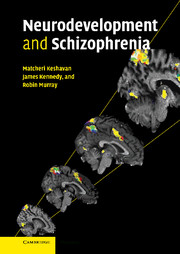Crossref Citations
This Book has been
cited by the following publications. This list is generated based on data provided by Crossref.
Rutter, Michael
2005.
Multiple meanings of a developmental perspective on psychopathology.
European Journal of Developmental Psychology,
Vol. 2,
Issue. 3,
p.
221.
Keshavan, Matcheri S.
Diwadkar, Vaibhav A.
Montrose, Debra M.
Rajarethinam, Rajaprabhakaran
and
Sweeney, John A.
2005.
Premorbid indicators and risk for schizophrenia: A selective review and update.
Schizophrenia Research,
Vol. 79,
Issue. 1,
p.
45.
Rutter, Michael
Kim‐Cohen, Julia
and
Maughan, Barbara
2006.
Continuities and discontinuities in psychopathology between childhood and adult life.
Journal of Child Psychology and Psychiatry,
Vol. 47,
Issue. 3-4,
p.
276.
Rutter, Michael
2007.
Psychopathological Development Across Adolescence.
Journal of Youth and Adolescence,
Vol. 36,
Issue. 1,
p.
101.
Pillai, Anilkumar
2008.
Brain-Derived Neurotropic Factor/TrkB Signaling in the Pathogenesis and Novel Pharmacotherapy of Schizophrenia.
Neurosignals,
Vol. 16,
Issue. 2-3,
p.
183.
Lesch, Bluma J.
Gehrke, Andrew R.
Bulyk, Martha L.
and
Bargmann, Cornelia I.
2009.
Transcriptional regulation and stabilization of left–right neuronal identity in C. elegans.
Genes & Development,
Vol. 23,
Issue. 3,
p.
345.
Pillai, Anilkumar
Kale, Anvita
Joshi, Sadhana
Naphade, Nilesh
Raju, M. S. V. K.
Nasrallah, Henry
and
Mahadik, Sahebarao P.
2010.
Decreased BDNF levels in CSF of drug-naive first-episode psychotic subjects: correlation with plasma BDNF and psychopathology.
The International Journal of Neuropsychopharmacology,
Vol. 13,
Issue. 04,
p.
535.
Tiwari, Arun K.
Zai, Clement C.
Müller, Daniel J.
and
Kennedy, James L.
2010.
Genetics in schizophrenia: where are we and what next?.
Dialogues in Clinical Neuroscience,
Vol. 12,
Issue. 3,
p.
289.
Freedman, David
and
Brown, Alan S.
2011.
The developmental course of executive functioning in schizophrenia.
International Journal of Developmental Neuroscience,
Vol. 29,
Issue. 3,
p.
237.
Weis, Serge
2012.
Pathologie.
p.
467.
Rutter, Michael
2015.
Self-Regulation in Adolescence.
p.
123.
Freedman, David
and
Woods, George W.
2018.
The developing significance of context and function: Neuroscience and law.
Behavioral Sciences & the Law,
Vol. 36,
Issue. 4,
p.
411.
Glannon, Walter
2018.
Psychiatric Neuroethics.



